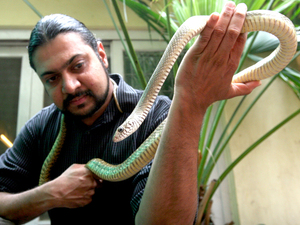I recently saw an article about how the iconic folk art of snake charming is dying away in India, partially as a result to animal-rights activists that feel the tradition is based on cruelty. It has become increasingly difficult to locate snake charmers, often old men with loosely wrapped turbans, sitting cross legged on the ground in front of flat baskets. However, during Nag Panchami, a yearly festival in honor of the king cobra, additional snake charmers tend to come out of the woodwork to celebrate. Lord Shiva, the blue-skinned Hindu god I mentioned in regards to a painting in an
earlier post, is often portrayed with a king cobra around his neck, hence the festival.
 |
A snake charmer in a New Delhi market charms a snake during Nag Panchami,
a yearly festival in honor of the king cobra. |
Snake charming is NOT what I expected. I always thought something about the music entranced the snake, but actually, snakes don't have ears and cannot hear the music. Instead, the snakes see the gourd flutes used by the charmers and interpret them as menacing, and are drawn to the swaying motion. Some charmers break off the snake's fangs or sew their mouths shut to keep hem from biting, which often results in the snake being unable to eat and starving to death, although some charmers adamantly defend their work saying they merely tame the animals through training.
In 1972, the Indian government made it illegal for people to keep snakes, however, until recently the law was not enforced much. The government has started to implant identification chips under the skin of some snakes that were already in captivity to be able to monitor charmers to make sure they are not capturing new snakes.
 |
| A representative from the animal rescue group "Wildlife SOS" holding a rat snake. |
Some snake rescue groups have developed to attempt to lure some charmers to new occupations like removing venomous snakes from urban areas and returning them to the wild. This has had some appeal to charmers as much of their traditional audience has been lured away in recent years by more modern entertainment.


whoa....didn't know that about their snakes.
ReplyDeleteThis comment has been removed by the author.
ReplyDeleteDat is back on line!!!
ReplyDelete